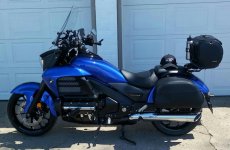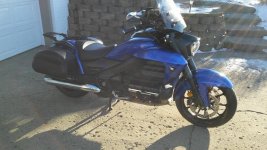-
There were many reasons for the change of the site software, the biggest was security. The age of the old software also meant no server updates for certain programs. There are many benefits to the new software, one of the biggest is the mobile functionality. Ill fix up some stuff in the coming days, we'll also try to get some of the old addons back or the data imported back into the site like the garage. To create a thread or to reply with a post is basically the same as it was in the prior software. The default style of the site is light colored, but i temporarily added a darker colored style, to change you can find a link at the bottom of the site.
You are using an out of date browser. It may not display this or other websites correctly.
You should upgrade or use an alternative browser.
You should upgrade or use an alternative browser.
Tools needed for Ryker wheel change
- Thread starter PW2013STL
- Start date
watertowerman
New member
View attachment 168057 love my Valkyrie cant wait for my Rally Ryker
 I love my Valkyrie but can't wait to get my Ryker Rally
I love my Valkyrie but can't wait to get my Ryker Rallywatertowerman
New member
watertowerman
New member
I purchased a 65mm socket for the Ford axle/hub nut. It appears to be the same shape as the Ryker wheel nut and it was pretty inexpensive.
1st picture is of a standard, straight edge, hex cut socket. This one will certainly NOT work on the Ryker wheel nut.
The 2nd picture is of the socket I purchased with a rounded tooth configuration very similar to the Ryker rear wheel nut. A subtle but significant difference. I'm hoping to get lucky here but I have some doubts that it will work. Still, for the price I thought it worth a shot. We will soon see. It should deliver early next week.
View attachment 168088View attachment 168087
Did the socket fit?
BajaRon
Well-known member
Got the socket in and it fits.... sort of. It is just a bit loose. But otherwise, it mates up well enough to use as long as you're not doing it with an impact wrench. I thought I was getting something other than a standard 65mm socket. But a standard 65mm socket is what I got. Michaelscs called it in a previous post. To me the cut appears to be rounded in the picture of the socket (on the right) which is the one I purchased. It was supposed to be a Ford Hub Nut socket. But in reality, it is a straight cut.
This is the one I got. I'm not sure they sent me what they are claiming to be selling.
https://www.ebay.com/itm/CT4013-3-4...e=STRK:MEBIDX:IT&_trksid=p2057872.m2749.l2649
This is the one I got. I'm not sure they sent me what they are claiming to be selling.
https://www.ebay.com/itm/CT4013-3-4...e=STRK:MEBIDX:IT&_trksid=p2057872.m2749.l2649
HongKongPhooey
New member
So you didn't actually get the one in the ebay link? Sorry, I'm confused.
BajaRon
Well-known member
So you didn't actually get the one in the ebay link? Sorry, I'm confused.
I assumed that a Ford Hub Nut Socket was different than a standard 65mm socket. The picture appeared to me, to be different. But since I don't actually know if there is a difference, I have no idea. Maybe someone here does know.
IdahoMtnSpyder
Well-known member
Based on what I found w/ Google I think you got a Ford hub nut socket, meaning it is a socket for the Iveco and Ford Transit (made by Iveco??), but not for other Fords. In my pic above it looks like it is a straight cut normal type socket which I thought, based on the drawing in the parts diagrams and the photo from Smoaks video, would fit pretty good.Got the socket in and it fits.... sort of. It is just a bit loose. But otherwise, it mates up well enough to use as long as you're not doing it with an impact wrench. I thought I was getting something other than a standard 65mm socket. But a standard 65mm socket is what I got. Michaelscs called it in a previous post. To me the cut appears to be rounded in the picture of the socket (on the right) which is the one I purchased. It was supposed to be a Ford Hub Nut socket. But in reality, it is a straight cut.
This is the one I got. I'm not sure they sent me what they are claiming to be selling.
How about posting a clear straight on photo, with dimensions, of the Ryker hub nut?
???? Why doesn't someone just go to a Ford Dealer and ask the Service Mgr to see if the official tool fits.
You all are making this too hard and complicated. Also stop your Ryker dealer and ask to see their official tool.
You all are making this way too complicated...........Ride your Ryker and give their tool a try. :banghead:
You all are making this too hard and complicated. Also stop your Ryker dealer and ask to see their official tool.
You all are making this way too complicated...........Ride your Ryker and give their tool a try. :banghead:
BajaRon
Well-known member
Dumb question, but an oil remover is 65mm do you think that would work??
If you mean an oil filter remover socket, then no. No way that stamped steel socket will take 215 lb. ft. torque. You'd twist that thing off before you got half way to the correct torque.
My opinion, the 65mm straight cut socket will work just fine. It does not fit perfectly, which I assume the BRP special socket would. But it's close enough to get the job done. I need to get a bigger torque wrench. Once I have it I will give it a try and let everyone know how it goes. The worst case scenario will be it may scar up the nut. No one is going to like that, including me. And probably a deal killer.
I should amend this a bit. I have not yet actually tried using this 65mm socket on the axle nuts. I've put it on but have not attempted to turn it yet. I don't want anyone to think I am recommending this yet. Just saying it appears that it will work.
Last edited:
I Once I have it I will give it a try and let everyone know how it goes. The worst case scenario will be it may scar up the nut. No one is going to like that, including me. And probably a deal killer.
I have good luck using this method to protect nuts from damage:
*************************************************
Cut a circle of heavy gauge plastic, at least 3 mil thick if you can find it. A heavy duty plastic bag works great. Make sure the circular piece of plastic is at least 50% larger that the outer diameter of the socket.
Hold the plastic over the center of the nut and tap the socket onto the nut with a dead blow hammer gently.
Apply the torque to the nut in a very slow and even manner.
Once the torque has broken free, you can pull the socket off the nut while it's still attach to the axel in this case.
Use a new piece of plastic sheet stock to install the nut.
BajaRon
Well-known member
I have good luck using this method to protect nuts from damage:
*************************************************
Cut a circle of heavy gauge plastic, at least 3 mil thick if you can find it. A heavy duty plastic bag works great. Make sure the circular piece of plastic is at least 50% larger that the outer diameter of the socket.
Hold the plastic over the center of the nut and tap the socket onto the nut with a dead blow hammer very gently.
Apply the torque to the nut in a very slow and even manner.
Once the torque has broken free, you can pull the socket off the nut while it's still attach to the axel in this case.
Use a new piece of plastic sheet stock to install the nut.
Great idea! Especially considering that there is a bit of play between the 65mm straight cut socket I have and the nut. With dimensions this big, it is my experience that you do not necessarily need a perfectly fitting tool if you take a bit of care. You should not, in any case, be using a rattle gun on this wheel nut anyway. And a good torque technique is slow and steady. Which I believe should work to protect the axle nut.
I have an appropriate torque wrench on the way. My current tool would not go to the 225 lb. Ft. setting needed. When it gets here I am going to take a nut off and put it back on. I'll let you know what I find. For the price of a BRP socket, you can get a 65mm socket and decent torque wrench too.
Update: 250 lb. ft. torque wrench will be here Friday.
Last edited:
I have good luck using this method to protect nuts from damage:
*************************************************
Cut a circle of heavy gauge plastic, at least 3 mil thick if you can find it. A heavy duty plastic bag works great. Make sure the circular piece of plastic is at least 50% larger that the outer diameter of the socket.
Hold the plastic over the center of the nut and tap the socket onto the nut with a dead blow hammer gently.
Apply the torque to the nut in a very slow and even manner.
Once the torque has broken free, you can pull the socket off the nut while it's still attach to the axel in this case.
Use a new piece of plastic sheet stock to install the nut.
This method as two added benefits:
1. In this instance it holds the socket onto the nut, which is specially important if you must use an extension between the socket and the torque wrench. It holds all of the parts together during the process of torquing or un-torquing, allowing one person to accomplish the task.
2. This method does away with the need for a separate set of magnet embedded sockets. If you want to install a nut on a very hard to reach bolt or stud, say for instance inside a car door panel all you have to do is cut a circle of place out of a heavy plastic bag, place the socket on a table with the broached end up, place the plastic sheet stock on top of the socket, place the nut on top of the sheet stock and tap the nut into the socket with a dead blow hammer. The nut is retained to allow for you to start the nut in a blind location etc. One further tip. Cut the plastic sheet into a long strip instead of circle. Use one end of the strip to hold the nut and the other end allows you to hold to or retain the plastic sheet stock so it does not drop down into the car door panel in this case, or engine compartment of a car or airplanes exc.
How to make an improvised torque wrench for the Ryker wheel nuts.
How to make an improvised torque wrench for the Ryker wheel nuts.
You need:
Socket
Breaker Bar
6ft 3in Breaker bar extension tube. (plus a few inches longer) Hint: 1 inch diameter steel electrical conduit tubing works well and it is cheap.
5 gallon bucket
4.5 gallons of water
Fashion a breaker bar extension out of steel tubing plus several inches extra in length, cut a notch at the 6ft 3in mark to hold the water bucket handle. Pre-torque the nut modestly with mild force from your hand on the end of the breaker bar. Next hang the bucket containing 4.5 gallons of water on the breaker bar extension engaging the notch to hold it in place. This amount of weight will torque the nut to 225ft/lbs.
How to make an improvised torque wrench for the Ryker wheel nuts.
You need:
Socket
Breaker Bar
6ft 3in Breaker bar extension tube. (plus a few inches longer) Hint: 1 inch diameter steel electrical conduit tubing works well and it is cheap.
5 gallon bucket
4.5 gallons of water
Fashion a breaker bar extension out of steel tubing plus several inches extra in length, cut a notch at the 6ft 3in mark to hold the water bucket handle. Pre-torque the nut modestly with mild force from your hand on the end of the breaker bar. Next hang the bucket containing 4.5 gallons of water on the breaker bar extension engaging the notch to hold it in place. This amount of weight will torque the nut to 225ft/lbs.
QuasiMotard
New member
I have good luck using this method to protect nuts from damage:
*************************************************
Cut a circle of heavy gauge plastic, at least 3 mil thick if you can find it. A heavy duty plastic bag works great. Make sure the circular piece of plastic is at least 50% larger that the outer diameter of the socket.
Hold the plastic over the center of the nut and tap the socket onto the nut with a dead blow hammer gently.
Apply the torque to the nut in a very slow and even manner.
Once the torque has broken free, you can pull the socket off the nut while it's still attach to the axel in this case.
Use a new piece of plastic sheet stock to install the nut.
Yessir, that works. Depending on the thickness of your buffer plastic, extracting the socket from the nut/axle can be challenging, though. I've needed to resort to a padded bench vice and a gear puller once or twice before to save me from my own ingenuity. The same process works in reverse for Japanese JIS fasteners... our SAE Philips bits don't quite match and you end up "smearing" your screw heads. A bit of thick PVC bag or a piece of friction tape in the screw head helps sometimes with that, particularly with impact-tools (e.g. #3-4 Philips head in a not-quite equally sized JIS screw).
However, I'm not recommending that course of action to anyone until I have tried it on my own machine! In the Ryker's case, I might bite the proverbial bullet and let the dealer handle the wheel issues. So, if they mangle the nut, then I don't have to beat myself up over it.
--
QM
Last edited:
A heat gun on the socket will allow the socket to slide off rather easily from my experience. The plastic softens up at a rather low temp and slight tapping with a dead blow hammer on the corner of the socket very gently will allow the socket to slip free. Also apply some lubricant to the nut and in the socket before you press the two together. I've never had a problem at all using this method.
QuasiMotard
New member
A heat gun on the socket will allow the socket to slide off rather easily from my experience. The plastic softens up at a rather low temp and slight tapping with a dead blow hammer on the corner of the socket very gently will allow the socket to slip free. Also apply some lubricant to the nut and in the socket before you press the two together. I've never had a problem at all using this method.
:agree:
I didn't think that far out of the box, apparently. My situation had some attached o-rings and bronze thrust washers near the focal point that may not have taken the localized heat. But for a wheel nut/axle combo like this the heat trick would be perfect. Well analyzed, sir!
--
QM
Similar threads
- Replies
- 4
- Views
- 3K
- Replies
- 37
- Views
- 10K
- Replies
- 66
- Views
- 40K
- Replies
- 13
- Views
- 2K


